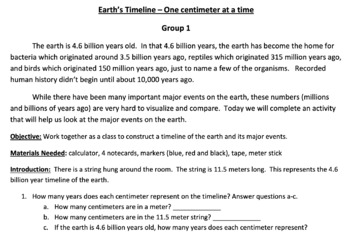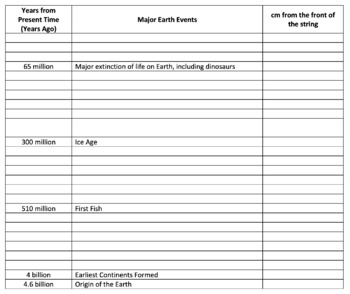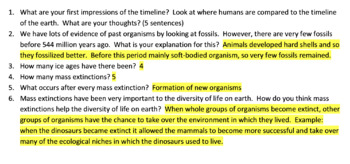Timeline of Life on Earth ACROSS THE ROOM!
CalmAndConfidence
105 Followers
Grade Levels
8th - 12th
Subjects
Resource Type
Standards
NGSSHS-LS4-1
NGSSHS-ESS1-5
NGSSHS-LS4-4
NGSSHS-LS4-5
Formats Included
- PDF
Pages
15 pages
CalmAndConfidence
105 Followers
What educators are saying
I used this resource with my year 11 biology class. We had a great time and it was so engaging! They were able to make up some really great cards to teach each other about events in geological history. It was perfect for hitting the syllabus point in NSW Preliminary Biology.
Description
This is such a fun activity/teaching tool! Hang an 11.5-meter string/wire across the room and student groups work to tape notecards along it corresponding to events during Earth's timeline.
Each of the 7 groups receives a 2-page document with pre-lab and post-lab questions, the calculations to complete, and group roles.
- Students calculate how many centimeters are in 11.5 meters, then how many years each centimeter will signify.
- Each team is assigned ~4 key dates in Earth's history to create notecards. (Color coding included)
- Peers then measure and attach the events to Earth's timeline. (Meter stick for each group recommended)
- As all groups complete their cards, students walk along the timeline observing the order of events and distance between events.
After all classes build their timeline, I generally select the best to leave up permanently. This installation is a great reminder for geologic time and key events as you cover new units.
Enjoy!
Total Pages
15 pages
Answer Key
Included
Teaching Duration
N/A
Report this resource to TPT
Reported resources will be reviewed by our team. Report this resource to let us know if this resource violates TPT’s content guidelines.
Standards
to see state-specific standards (only available in the US).
NGSSHS-LS4-1
Communicate scientific information that common ancestry and biological evolution are supported by multiple lines of empirical evidence. Emphasis is on a conceptual understanding of the role each line of evidence has relating to common ancestry and biological evolution. Examples of evidence could include similarities in DNA sequences, anatomical structures, and order of appearance of structures in embryological development.
NGSSHS-ESS1-5
Evaluate evidence of the past and current movements of continental and oceanic crust and the theory of plate tectonics to explain the ages of crustal rocks. Emphasis is on the ability of plate tectonics to explain the ages of crustal rocks. Examples include evidence of the ages oceanic crust increasing with distance from mid-ocean ridges (a result of plate spreading) and the ages of North American continental crust decreasing with distance away from a central ancient core of the continental plate (a result of past plate interactions).
NGSSHS-LS4-4
Construct an explanation based on evidence for how natural selection leads to adaptation of populations. Emphasis is on using data to provide evidence for how specific biotic and abiotic differences in ecosystems (such as ranges of seasonal temperature, long-term climate change, acidity, light, geographic barriers, or evolution of other organisms) contribute to a change in gene frequency over time, leading to adaptation of populations.
NGSSHS-LS4-5
Evaluate the evidence supporting claims that changes in environmental conditions may result in (1) increases in the number of individuals of some species, (2) the emergence of new species over time, and (3) the extinction of other species. Emphasis is on determining cause and effect relationships for how changes to the environment such as deforestation, fishing, application of fertilizers, drought, flood, and the rate of change of the environment affect distribution or disappearance of traits in species.





